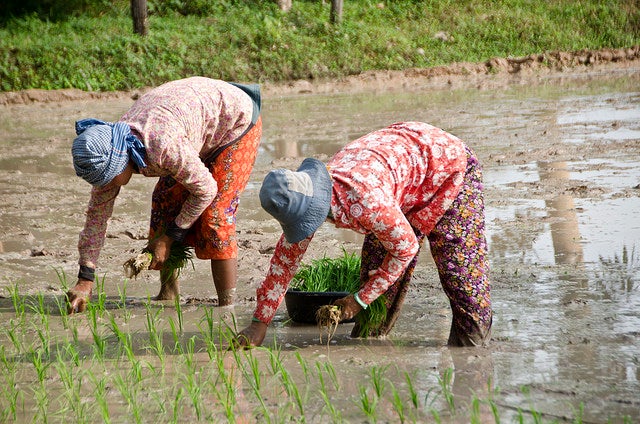
(Photo Credit: USAID/Flickr)
In a world faced with rising temperatures, increasingly severe droughts and floods, and a rapidly growing population, how can people adapt to this new way of life — and even thrive? Leading experts discussed this question in-depth during an Aspen Institute Global Health and Development Program event titled, “Building Resiliency: The Importance of Food Security and Population.” The panel took place as part of the Civil Society Policy Forum at the 2014 IMF/World Bank Spring Meetings in Washington, DC.
“Rapid population growth increases vulnerability to shocks of many kinds, including economic shocks, climate change impacts, and food insecurity,” said Clive Mutunga, population, health, and environment technical advisor at the US Agency for International Development (USAID). He noted that 222 million women around the world have an unmet need for family planning, which leads to high rates of maternal and infant mortality, early child-bearing, and high fertility rates that drive population growth. “Meeting women’s needs for reproductive health and family planning can contribute in important ways to building resilience in the face of these shocks.”
Making or Breaking the Next Generation
Proper nutrition impacts a child’s ability to grow and learn. “Building human capacity starts with the mother and young child,” said Meera Shekar, lead health and nutrition specialist in the Africa region at the World Bank. “Nutrition-sensitive agriculture is tremendously important in food security strategies that serve to build resilience. The first 1,000 days [of a child’s life] can lock in human capacity for life, and this can make or break a generation.”
Salif Niang, co-founder and chief impact officer for Malô SARL, a social enterprise working to build and operate modern facilities for small-holder farmers in Mali, emphasized the importance of the next generation of young people.
“In many countries, 80 percent of the population is under 30,” he pointed out. “In looking for jobs, many of these young people don’t see opportunities in farming… they see low productivity and old-fashioned methods. New technologies can both boost productivity and attract more young people — like the ability to engage your state-of-the-art drip irrigation system through an SMS from your cell phone.”
Developing such education and employment opportunities for youth could strengthen resilience and help many countries optimize the “demographic dividend,” when a relatively large proportion of the population is of working age.
Striving for Greater Access
The Food and Agriculture Organization has noted that given growing populations and rising incomes, by 2050 food production will need to increase by 70 percent. This is a daunting challenge, given that arable land and water supplies are already strained in many areas. Simply increasing production is not enough.
“Food security is not just about food availability,” noted Jason Clay, senior vice president of market transformation at the World Wildlife Fund. “It is also about the affordability of food, and people’s ability to access it.” Agricultural trade will play a growing role in getting food to the areas where it’s needed, but greater efforts are also needed to improve efficiency in food utilization: currently, one in three calories produced globally is wasted.
Policy changes at global and national levels that can help to improve access to food will need to be complemented by local efforts, noted Niang. For instance, in Mali, demand for rice is met primarily through imports, bypassing local producers, which leaves locals out of the economic chain.
To combat both issues of the need for better food access and local farm income, “solutions for food security need to be multi-dimensional,” Niang said. He described initiatives to build local capacity for marketing local goods, as well as behavior-change efforts to create demand for local products that can help meet food needs and generate income for farmers struggling to make a living.
Empowering Women
Joy Phumaphi, chair of the Global Leaders Council for Reproductive Health, emphasized the importance of empowering women in the context of food security, growing population, and climate change.
“A woman’s access to markets is critical for food security, as is her access to reproductive health,” she said. “Her ability to delay child-bearing until she is ready to sustain a family, and her capacity to participate in the marketplace, is critically linked to food production, food security, and her family’s ability to thrive.”
It is the great challenge of the 21st century to reduce global poverty, while coping with a changing climate, frequent crises, and greater demands for resources. Building resilience requires strategies and breakthrough solutions that take into consideration the interconnections of food security, reproductive health, and population.
Kathleen Mogelgaard is a consultant with the Aspen Institute’s Global Heath and Development Program.
